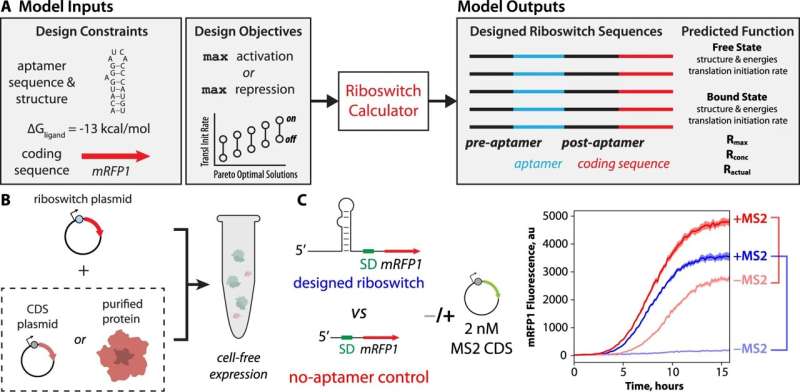This article has been reviewed according to Science X's editorial process and policies. Editors have highlighted the following attributes while ensuring the content's credibility:
fact-checked
peer-reviewed publication
trusted source
proofread
Engineers report low-cost human biomarker sensor designs

Penn State researchers have developed a low-cost, RNA-based technology to detect and measure biomarkers, which can help decode the body's physiology. The presence of protein biomarkers can indicate chronic or acute conditions, from arthritis to cancer to bacterial infections, for which conventional tests can cost anywhere from $100 to upwards of $1,000. The new technology can perform the same measurement for about a dollar.
The team published their results in Nature Communications, combining the efforts of Howard Salis, associate professor of biological engineering, chemical engineering and biomedical engineering; Grace Vezeau, who earned a doctorate in biological engineering from Penn State in 2021; and Lipika Gadila, who earned a bachelor of science in chemical engineering from Penn State in 2018.
The results demonstrate that RNA-based sensors can be engineered to detect human biomarker proteins, including monomeric C-reactive protein, which is involved in chronic inflammatory conditions such as heart disease and arthritis, and interleukin-32 gamma, a signaling protein for acute infections like viruses or bacterial infections. According to Salis, such sensors could be used to develop devices for diagnostic testing.
"These tests can help a clinician diagnose a patient, but it's more informative to carry out multiple biomarker measurements periodically over the span of several weeks," Salis said. "Right now, one test can be expensive, and they add up. With our new RNA-based technology, it's now possible to carry out the same measurements for much less."
The technology is a combination of a cell-free expression system and engineered RNA-based sensors called riboswitches. Cell-free expression systems contain cellular machinery to read DNA and produce proteins, but they are not restricted by cell membranes and allow bulky proteins to freely enter.
The riboswitches are engineered to bind to a biomarker protein and regulate the activation or repression of an observable signal. The riboswitch itself is produced inside the cell-free expression system from DNA instructions. Altogether, the cost of these materials is about a dollar per reaction.
According to Salis, this is the first time that researchers have engineered a riboswitch sensor to detect biomarker proteins. The challenge, he said, is figuring out the best DNA instructions to generate the most sensitive protein sensors.
"Past efforts to engineer such riboswitch sensors have largely relied on trial-and-error experimentation, for example, constructing and characterizing large random libraries to identify riboswitch variants—the genetic blueprints and aptamers—that work best," Salis said. "Using a combination of thermodynamic modeling and computational optimization, we rationally designed new riboswitches that are predicted to be excellent protein sensors and then we tested them. Our design algorithm is called the Riboswitch Calculator."
Salis and the researchers tested their new technology to detect three proteins: MS2, a small protein found in a bacterial phage, as a proof-of-principle test; and the medically relevant biomarkers human monomeric C-reactive protein and human interleukin-32 gamma. The researchers engineered 32 riboswitches, most of which successfully sensed their target proteins.
"Current assays require expensive detection reagents, expensive and bulky instruments, sample cold chain storage and distribution, and trained personnel," Salis said. "By applying modeling and computational design, we engineered low-cost protein sensors that can be freeze-dried and rehydrated. The next step is to develop an easy-to-use device that allows researchers and clinicians to use this new technology."
More information: Grace E. Vezeau et al, Automated design of protein-binding riboswitches for sensing human biomarkers in a cell-free expression system, Nature Communications (2023). DOI: 10.1038/s41467-023-38098-0
Journal information: Nature Communications
Provided by Pennsylvania State University





















